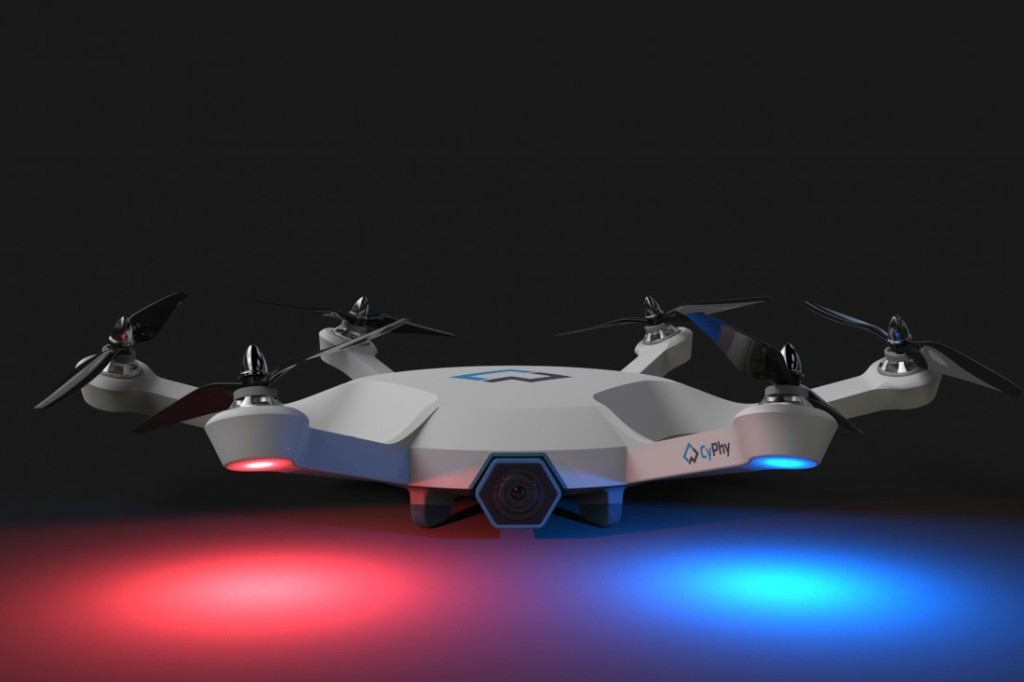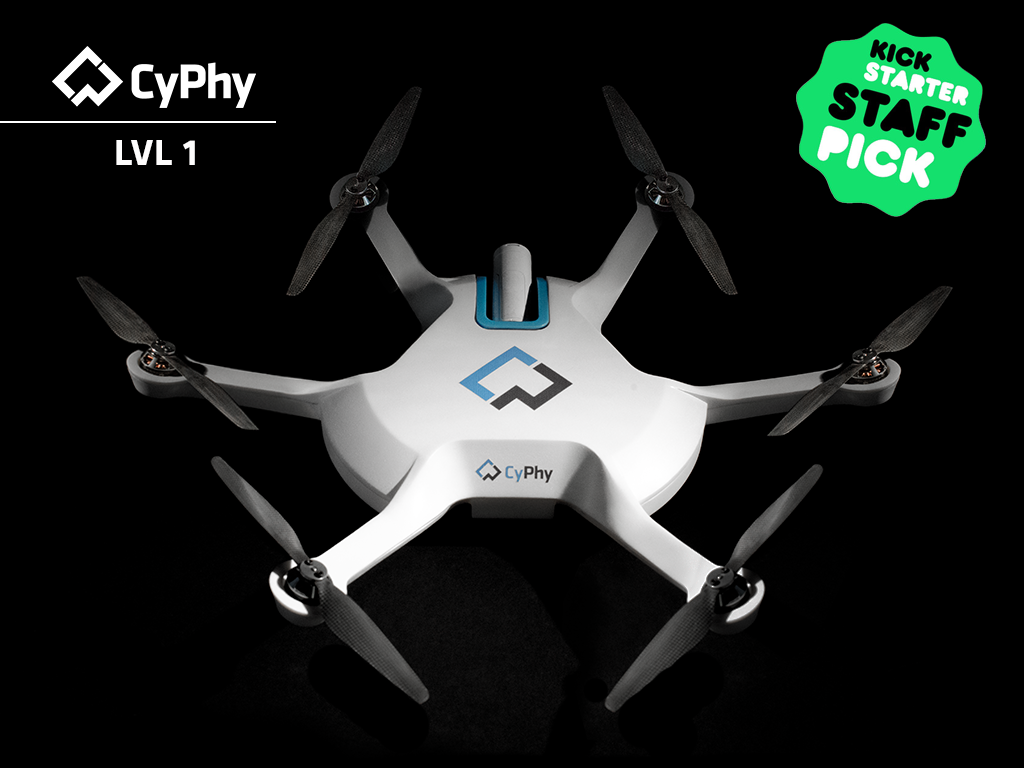
Robohub.org
184
CyPhy LVL 1 Drone with Helen Griener


In this episode, Audrow Nash speaks with Helen Greiner, CEO and founder of CyPhy Works and co-founder of iRobot, about CyPhy Work’s LVL 1 photography drone. The LVL 1 drone has six propellers that are angled up and rotated slightly, which allows the drone to fly without tilting; flying without tilting is significant because, Helen says, it makes the drone more intuitive to control, as well as removing the need for a costly and high-maintenance camera stabilizing gimbal system.
CyPhy Works has an KickStarter campaign for the LVL 1 drone that ends June 18th, 2015. The Kickstarter video and a link to the campaign are below.
Helen Griener
 Helen Greiner co-founded iRobot in 1990 and served as President until 2004 and Chairman until 2008. During her tenure, Ms. Greiner guided iRobot into its position as a global leader with the release of the Roomba™, the PackBot™and SUGV military robots. She built a culture of practical innovation and delivery that led to the deployment of 6,000 PackBots. In addition, Ms. Greiner headed up iRobot’s financing projects, raising $35M in venture capital for a $75M initial public offering. Greiner holds a bachelor’s degree in mechanical engineering and a master’s degree in computer science, both from the Massachusetts Institute of Technology.
Helen Greiner co-founded iRobot in 1990 and served as President until 2004 and Chairman until 2008. During her tenure, Ms. Greiner guided iRobot into its position as a global leader with the release of the Roomba™, the PackBot™and SUGV military robots. She built a culture of practical innovation and delivery that led to the deployment of 6,000 PackBots. In addition, Ms. Greiner headed up iRobot’s financing projects, raising $35M in venture capital for a $75M initial public offering. Greiner holds a bachelor’s degree in mechanical engineering and a master’s degree in computer science, both from the Massachusetts Institute of Technology.
Links
- Download mp3 (10.7 MB)
- Subscribe to Robots using iTunes
- Subscribe to Robots using RSS
- Link to LVL 1 Kickstarter campaign
Transcript
Audrow Nash: Hi, welcome to Robots Podcast. Can you introduce yourself?
Helen Greiner: My name is Helen Greiner and I’m the CEO and founder of CyPhy Works, the drone company.
Audrow Nash: Can you tell me about your career?
Helen Greiner: I saw a competition on the Discovery Channel of students building robots out of a kit of parts at MIT, and I decided I want to go there because those students looked like they were having a heck of a lot of fun building robots. I went to MIT, I interned at the jet propulsion laboratory, and then I did my masters also at MIT in Electrical Engineering and Computer Science. I was accepted to the PhD program and dropped out of it and started iRobot Corporation.
Audrow Nash: Now you are at CyPhy Works. Can you tell me a bit about the industrial drones that you make there?
Helen Greiner: We started at CyPhy Works with a very unique technology: a microfilament tether, which supplies power and communications, and [carries] video from the drones. With that, the drones have long, almost infinite times of flight because power is being supplied from the ground. And we’ve solved some of the communications challenges like being hacked or spoofed. We’ve built a drone that just goes up and stays up at 500 feet, 24/7.
Audrow Nash: You are releasing a drone you’re calling LVL 1. What are the primary applications that you expect the LVL 1 drone is going to be used for?
Helen Greiner: We’ve designed the LVL 1 as a consumer drone, so you can take it out and very practically look in your gutters for leaves, or, if a storm came through, look to see if a shingle blew off your house, or you can look at what’s going on in your neighborhood. And it’s also for fun. You can take it to that beach barbeque and get stunning photographs from a unique perspective. You can take videos of your kids out kayaking; you can take videos of your child’s soccer game.
There are just so many wonderful applications for drone photography, and I think it’s really taken the place of video cameras. Phones have taken a lot of the functionality, but there’s still a need to get great shots, and drones go beyond video cameras because you can get shots from up high. So you have unique perspectives, but you can also do rolling shots. Like if your child is on a bicycle or in a kayak, the drone can follow along with them. It’s better than a video camera in many respects because it can follow the action.
Audrow Nash: And it’s a consumer drone. Can you tell me about why you’ve made that transition from industrial and military to consumer?
Helen Greiner: We haven’t really transitioned to the consumer. We have a lot of very inventive engineers and drone scientists at the company and one of them, Kenneth Sebesta, came up with what we call “Level-Up Technology”. Most multi-rotors tilt into the direction of motion, and that means every sensor on them, including the camera, has to tilt with them. Companies have spent a lot of time building these fancy gimbal systems to compensate for that tilt.
What we’ve done is we’ve built a multi-rotor (a hex rotor) that just flies level. The way we’ve done that is by putting what we call a dihedral, which is the angle between the body of the drone and the rotors, we put an angle on that and we also give the strut a twist. A dihedral and a twist is how we get the level behavior. And of course it has to have a lot of fancy math and control code running on it.
Audrow Nash: How did you decide initially to make this drone?
Helen Greiner: Our drone scientist was working to make the Parc system, our larger drone, fly better in wind, and he was experimenting with twists on the struts. He was looking at the math behind it and noticed that if you put a dihedral as well as a twist you can get level flight or tilted flight if you want.
We quickly prototyped it, and our dronies started to fly it … and they loved it because it was such a better flight experience. We thought, “We’ve got to do something with this because this would be the right thing for a consumer drone.”
I really do believe this design is going to be the right design for consumers because it makes flying so much simpler. It’s very intuitive because it’s level flight. We pull the camera into the body, which means you’re just controlling the camera (rather than controlling a drone and then controlling a camera, which is kind of like patting your head and rubbing your stomach).
There are a lot of tech folks who like to do that, but it’s so much simpler if you just fly the camera. With the Level-Up Technology we actually have a very rapid yaw, which we don’t have on a regular quadrotor.
Audrow Nash: So it can rotate very quickly …
Helen Greiner: Yes, very quickly … and so now we can actually use that as your motion for the camera. It’s all come together as a very solid compact design, very rugged. We’ve talked to hobby shops, and they said that it’s never the drone that breaks; it’s always the camera gimbal. That’s because the gimbal is exposed and it takes the brunt of any hard landing; it’s also got wires flexing many times, and hobby shops spend a lot of time fixing people’s gimble system, and charging them for it. I think the LVL 1 drone will be a much more reliable drone.
Audrow Nash: This drone is significantly cheaper than most of comparable drones. Has that been accomplished largely by removing the gimbal system for holding the camera?
Helen Greiner: Yes, largely by removing the gimbal system, but we’re also making use of the smart phone as a controller. A smart phone makes a great controller because you’ve got a wonderful display touch screen, you have a Wi-Fi link already onboard, and it’s got a GPS in it. With the smart phone, many people already have all the elements you need for a drone controller.
Audrow Nash: Why six propellers?
Helen Greiner: The level of behavior does require six, and that’s because of the math that’s running inside it. Six also gives you a lot of other great features. For example, with the level of behavior we have, if one or some combination of two rotors breaks, the drone can still fly, which is very exciting.
Audrow Nash: If two of these propellers break it can still continue to fly, or is it just one?
Helen Greiner: Definitely one, and some combinations of two. [Greiner points to two propellers on the same side] If these two go out, you’re dead.
Audrow Nash: How is it controlled?
Helen Greiner: The primary mode of control will be the touch screen interface. It’s very easy to set an altitude and be able to drag the drone. You’re controlling the drone just like you would look at a picture in a map. People have already learned the workflow of that. You have a picture or a video coming back from the drone and you’re just controlling it, in a first person view within that screen. When you fly this, when you control the yaw, you’re just dragging across the screen, and it really feels like you’re tightly coupled to the robot. It’s very cool to feel it.
Audrow Nash: What about the follow-me behavior? How does that work?
Helen Greiner: We’re building on top of an open source project called Tau Labs, and Tau Labs already incorporates a follow-me behavior in the control code. We will have that when we release this, but user feedback so far on all the drones that have follow-me behavior is that it’s not that useful yet, and it probably won’t be that useful until you can have sense-and-avoid to make sure that it’s safe. Right now it’s really useful if you’re in the desert, on the ocean, or where there’s a wide open space. But we’d never want to use follow-me behavior today in your city park.
Audrow Nash: Speaking of sense-and-avoid behavior, does this have the ability to do any of that?
Helen Greiner: It doesn’t have sense-and-avoid yet.
Audrow Nash: Are there ultrasonic sensors, or anything for it to determine what’s around it?
Helen Greiner: No, not at the moment.
Audrow Nash: You have a new thing called “geo fencing” – can you tell me about that?
Helen Greiner: People who haven’t flown a drone before are a little intimidated for the first flight, and they read on the internet about how during someone’s first flight they run it into a tree or it goes off into the neighbor’s yard. We’ve created a very simple interface that let’s you walk a boundary and the robot will stay in that boundary and not go out of it so it can’t get in any trouble as you’re taking those first flights. But it can be also useful for the sophisticated user that wants to practice aerodynamic flight, so the drone doesn’t get away from you. It’s based on the Tau Labs code.
There are all kinds of features to make any polytope … any kind of a shape that you would like … and keep the robot in that. But that’s not what our users want. We’ve developed an intuitive interface, where you walk the boundary and it stays in that boundary. You don’t have to do any correspondence between a map on your cell phone and what’s happening in the physical world. You’re constructing the boundary in the physical world.
Audrow Nash: No punching in GPS coordinates?
Helen Greiner: No punching in GPS coordinates.
Audrow Nash: But this does rely on GPS to create the geo fence, correct?
Helen Greiner: It does, yes.
Audrow Nash: Is that challenging given that GPS can be fairly inaccurate unless you buy an expensive one?
Helen Greiner: You wouldn’t want to make your geo fence in an extremely confined area. We’re only as good as the GPS accuracy, but the GPS accuracy locally at a certain point in time is usually pretty good. It can vary over days and when satellites move from place to place, but the local time of GPS is usually reasonably accurate.
Audrow Nash: Can you use an RC transmitter to control this?
Helen Greiner: You can. We’ve put payload ports on the bottom of the robot, so you can take off the stumpy little feet and there are connectors and power that allow you to connect a radio receiver.
When you want to do acrobatics, you do need to turn off Level-Up mode because it’s going to keep you flying level and that’s not going to allow for fun loops and flips. But one of the great things about the Level-Up Technology is that you can have it on to get that great video, and then you can turn it off if you want to have large accelerations.
Audrow Nash: Can you talk a bit about using open source technology in a consumer product?
Helen Greiner: There’s a lot of work that’s already being done by several communities in making autopilots that work well. The cofounder of Tau Labs is also the inventor of the Level-Up technology, so it was a no-brainer for us to use the Tau Labs open source code.
Audrow Nash: Will you be doing software updates to the LVL 1 drone?
Helen Greiner: Yes, we plan to make additional features along the way.
Audrow Nash: Congratulations on the successful Kickstarter campaign. You’re now more than double what you wanted …
Helen Greiner: It’s been wonderful. We’ve established a great community that we think of as our community of support and a lot of the basic design is done. But there’s a myriad of design decisions along the way and we’re getting a lot of feedback on what’s important to our customers and what’s not. It was a great thing to do a crowd funding campaign.
Audrow Nash: You’re pushing into some stretch goals. What are you thinking to implement now that you’ve received a good bit more than you originally asked?
Helen Greiner: Our first stretch goal is a camera control pack. The camera control pack will allow things like time-lapse photography and burst mode photography.
Audrow Nash: For a drone with limited battery life, I’m curious how time lapse would work …
Helen Greiner: It just gives you more high-resolution images at certain time intervals. Like if the sun is setting you get really high resolution, we like to say a beautiful sunset happens one minute at a time. Also on the camera control pack there’s RAW photography mode and features to let you control exposure and aperture and other things that really appeal to enthusiastic photography buffs, and they’ve never had a drone where you can get access to the data coming from the camera before.
Audrow Nash: What have been some of the major obstacles with the LVL 1 drone?
Helen Greiner: I think the major obstacle, because we are a small company, has been resource allocation. We didn’t stop what we were doing; we haven’t “pivoted” as they say. We are continuing to go strong in the industrial realm but we also wanted to get this consumer product, so we made the decision to prototype it quickly. We had a very enthusiastic team put in their sweat equity and really push it through from the grassroots. And we got it up on Kickstarter where it’s just going so well, and we’ve had such an enthusiastic response from the community.
Audrow Nash: Wrapping up, what advice do you have for those who want to do a startup?
Helen Greiner: If you want to do a startup, just go for it. You do want to have a solid idea first, and you can develop that idea when you’re in school or when you’re working at another job. But once you have that idea and it’s something that you’re passionate about, I’d say go for it, because the worst case scenario is that it doesn’t work out. And in this country … in the United States … it’s a badge of honor if you’ve tried it, even if it doesn’t work out. You can always go on to the next thing, which might be another startup or it might be going back to school. It could be anything … but at least you know you have tried it. And if it works out you will be living your dream.
Audrow Nash: Thank you.
Helen Greiner: Thank you.
All audio interviews are transcribed and edited for clarity with great care, however, we cannot assume responsibility for their accuracy.
tags: Actuation, Business, c-Aerial, Crowd Funding, crowdfunding, cx-Consumer-Household, CyPhy Works, Flying, Helen Greiner, podcast, robot




